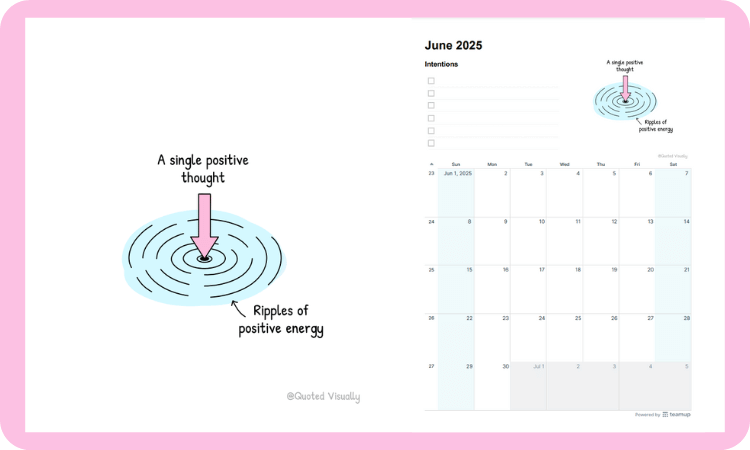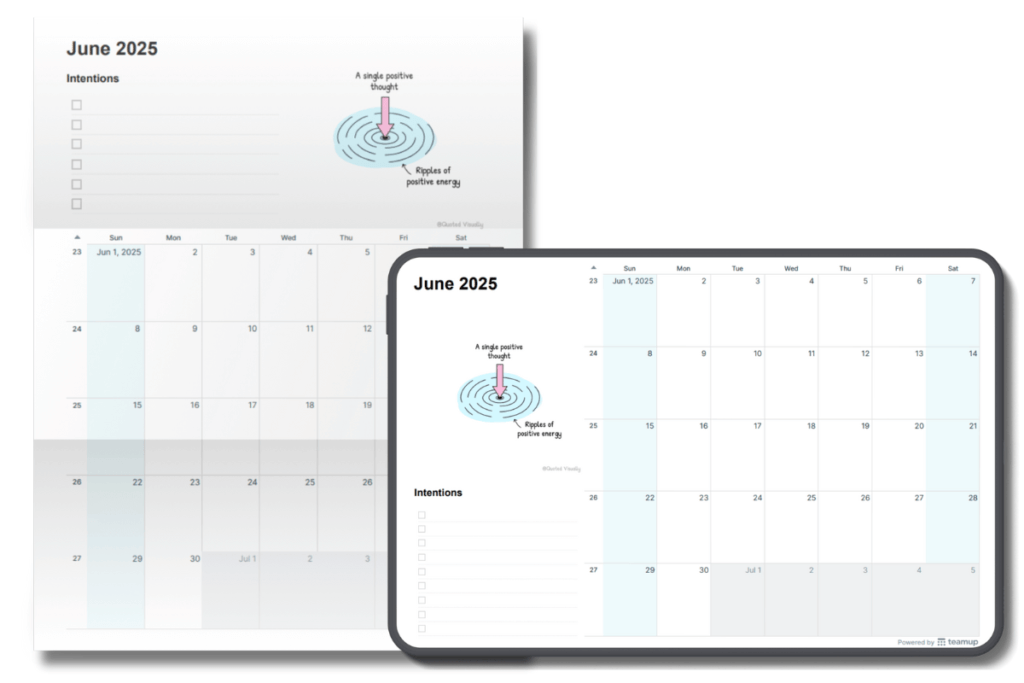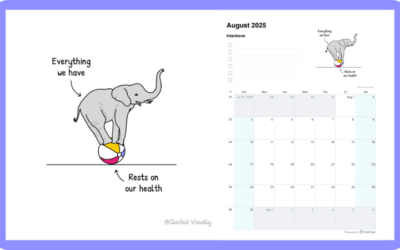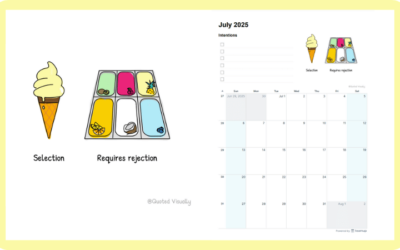A single positive thought creates ripples of positive energy. Stay positive with our June illustrated calendar, available to download and print in portrait or landscape. See our complete collection of 2025 printable calendars for even more options.
A single positive thought won’t change your whole life in an instant, but it can shift your outlook, change how you interact with people, and even influence how your brain works. And while there’s a lot we can’t control in life, we can pause and shift our thinking. So it’s worth understanding how the ripple effect works, and how to use it on purpose to create positive momentum.
Your brain on positivity
Your brain is constantly filtering the world based on what it believes is important. And what’s important to your brain changes based on how much attention it gets from you. When you’re focused on something (thinking about it with frequency and intensity), your brain gets a directive: This thing is important, so show me more of it!
That’s a useful brain function, except when it isn’t. If you’re focused on negative experiences and reactions, scary unknowns, fears and worries, your brain thinks you want to notice more of those things. Not great. But when you shift a thought from negative to positive, you start shifting your brain’s “importance” filter. And that has a pretty big impact.
- A single positive thought can trigger the release of dopamine or serotonin, two chemicals in your brain that influence mood, focus, and even your immune system.
- This change in your brain chemistry can lead to a more relaxed, hopeful feeling and outlook overall, which makes it easier to keep having more positive thoughts.
Studies in cognitive behavioral therapy (CBT) show that changing your thoughts can shift your emotional and physical responses. Positive psychology research confirms that even brief moments of optimism or gratitude can improve resilience and mood, and even boost productivity.
In other words, each positive thought has an immediate effect, generating energy that ripples out into a better mental and physical state, building positive momentum. As these positive thoughts stack up, they can even change the actual structure of your brain. Who says positive thinking isn’t powerful?
Perspective, not pretending
Positive thinking doesn’t mean pretending everything is fine when it’s not. It’s not about ignoring real problems or minimizing pain. And it’s not slapping on a smile, or a smiley-face sticker, when you face difficult, daunting things. Real positivity isn’t about denying hard things. It’s about responding to them differently. And it’s about choosing what gets your attention.
Instead of obsessing over what might go wrong, you ask: What can go right? Instead of seeing only the difficulty or pain, you find context and put things in perspective:
- That conversation was difficult, but it led to a real connection.
- This project is overwhelming, but my team is capable. And it will be a real achievement for all of us.
- Things are going as planned, but I’m handling it well and learning a lot.
Small shifts to build momentum
Positive thinking is rooted in reality. It doesn’t ignore tough feelings or difficult situations. Instead, positive thinking helps you stay grounded and focused, by acknowledging the reality you’re in and finding better thoughts in response, so you move in the direction you actually want to go. Each small shift matters. Here are a few ways to gain positive thinking traction in your day:
1. Keep track of your progress
Instead of focusing on how far you still have to go, pause to notice what’s already improving. Maybe you were more patient today than yesterday. Maybe you made it to the gym for 20 minutes instead of skipping. Notice and track your progress even if it’s not huge; consistency matters, and giving yourself credit helps build more energy toward your goals.
2. Look for small sources of delight
Pause a little more often and give yourself time to notice what’s already there. The stream of sunlight coming through the window, or a text from a friend. A good smell, a good feeling, a moment of laughter or ease. Just notice and let yourself acknowledge that bit of delight you get to experience. Your attention trains your brain to register more of what’s good instead of scanning for what’s wrong.
3. Share something that feels good
Tell other people what’s bringing you a bit of joy. Point out the things that delight you. And when you notice something that’s perfect for a friend, send it on. A thought like “I bet this would make them smile” can shift your focus outward. It’s a perspective shift, however small, and it helps you focus on connection instead of whatever’s got you stressed.
4. Choose questions over criticism
When something goes wrong, it’s easy to go straight into blame. Whether you focus on your own part (“Why do I always mess things up?”) or someone else’s (“How could they make this mistake?”), it doesn’t help. What happened has already happened. Blame doesn’t help. Learning does. Shift into curiosity with better questions like,“What can I do differently next time?” Point yourself towards action instead of judgment, and you can build confidence even from mistakes.
Start small, ripple out
Choosing a positive, constructive thought won’t instantly fix things. But it creates more mental space and emotional perspective. Instead of slipping deeper into frustration or inertia, you get a foothold for climbing out of negativity. Once you start stacking those moments, it gets easier to keep going. A single positive thought does generate a ripple of positive energy. If you’re ready and willing, you can build that ripple into a wave of positive momentum that keeps going.




